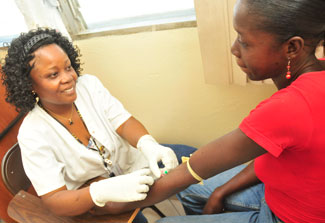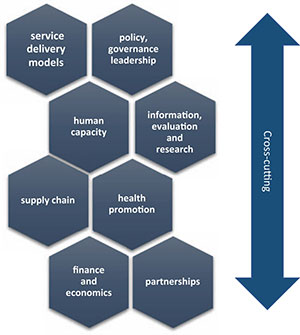
Research to guide practice: Enhancing HIV/AIDS platforms to address NCDs in sub-Saharan Africa
Research to guide practice: Enhancing HIV/AIDS platforms to address NCDs in low-resource settings (the HIV/NCD Integration Project) aims to bring together researchers, implementers and government representatives to articulate practical goals, approaches and a related research agenda to incorporate prevention, care and treatment for noncommunicable diseases (NCDs) into HIV/AIDS platforms in sub-Saharan Africa (SSA).
The NIH, with leadership from the Center for Global Health Studies (CGHS) at Fogarty, is conducting the project in collaboration with the President's Emergency Plan for AIDS Relief (PEPFAR) and the partners listed below. The program focuses on people living with HIV (PLHIV), many of whom are being treated successfully for HIV but who are increasingly experiencing comorbid diseases.
Context

Photo by Hugue-Robert Marsan for Fogarty/NIH
NIH and its partners are working to establish research
evidence that existing resources supporting people living with
HIV can be used] to help treat NCDs.
evidence that existing resources supporting people living with
HIV can be used] to help treat NCDs.
The rapidly rising burden of NCDs in low- and middle-income countries (LMICs) threatens to create a new epidemic that the global community can begin to address by establishing the evidence base necessary to leverage existing HIV investments in LMIC health systems. The existing human capital, health infrastructure, and data systems developed to confront the HIV/AIDS crisis could be enhanced, with the help of scientific evidence, to start to address patient management and prevention of NCDs for PLHIV. Research gaps, identified through a three-stage process, will guide and support interventions that build on the existing HIV/AIDS investments to address the dual disease burden facing PLHIV.
Activities and Implementation
This endeavor is led by a steering committee of subject matter experts from the U.S. and LMICs, and supported by an NIH-led, interagency secretariat. The HIV/NCD Integration Project is a collaborative effort with representatives from NIH Institutes, Centers and Offices, PEPFAR implementing agencies, and the Office of the Global AIDS Coordinator, and involving researchers, program implementers, funders, nongovernmental organizations, multilaterals, policymakers, universities, and ministry officials from LMICs and the U.S. that are all working together to develop and implement a research agenda addressing the rising NCD burden in PLHIV in LMICs.
Landscape Analysis and Research Agenda
The HIV/NCD Integration Project, comprised of more than 40 members, first identified four priority NCDs (i.e., cardiovascular disease, cervical cancer, depression, and diabetes) based on available data, known patho-physiological connection with HIV, associated HIV outcomes, along with other factors. These members conducted scoping reviews of what is currently being done in the field of NCD prevention, care, and treatment for PLHIV in SSA by examining peer-reviewed and gray literature focused on the four selected NCDs. The resulting analysis reported and identified gaps for integration of NCDs into the HIV clinical continuum of care, piloting and scaling-up an integrated chronic care health system, and enhancing HIV/NCD community engagement and health promotion efforts.
Health System Building Blocks
Chart of a modification of WHO's health system building
blocks, Figure 1 from the article Building on the HIV
chronic care platform to address noncommunicable
diseases in sub-Saharan Africa: a research agenda .
blocks, Figure 1 from the article Building on the HIV
chronic care platform to address noncommunicable
diseases in sub-Saharan Africa: a research agenda .
In addition to these landscape analysis, researchers, program implementers and policymakers from eight countries in SSA met to share lessons learned from existing, evidence-based integrated models of HIV and NCD care. Through this process, they developed an implementation science research agenda that identified priority questions related to enhancing NCD and HIV services to optimize patient and program outcomes.
Subject matter experts engaged in the project reviewed the findings from the landscape analysis and the integrated HIV/NCD modeling workshop to develop a prioritized research and activity agenda for the project. The result of this work is a 12-article supplement published in AIDS in July 2018 presented through health system building blocks (shown left) that represents the foci of research activities necessary for developing an integrated chronic care platform. In addition, several NIH ICs issued RFAs that included support for researchers addressing the integration of NCDs and HIV.
NCD Data Modeling
In response to the need for more data, the HIV/NCD Integration Project is supporting the development of models to estimate the burden of the four priority NCDs in PLHIV in SSA - a priority research area identified by the members. The HIV/NCD Integration Project, through a call for modeling proposals by CRDF Global , is supporting the development of models to estimate the burden of NCDs like cervical cancer, diabetes, depression and cardiovascular disease in PLHIV in sub-Saharan Africa - a research area identified as a priority under the project.
After an extensive review by modeling experts, the following awards have been made:
- Preparing for the Noncommunicable Disease Burden Among HIV-positive Persons in Kenya
Principal Investigator: Timothy Hallett, Imperial College London, UK - Assessing the Burden of Noncommunicable Diseases for People Living with HIV in Uganda
Principal Investigator: Stephane Verguet, Harvard School of Public Health - Integrated Modeling of Epidemiologic and Economic Long-term Outcomes in Africa
Principal Investigator: Omar Galarraga, Brown University
Steering Committee
- Wafaa El-Sadr, Columbia University, Member of Fogarty Advisory Board
- Robert Ferris, USAID
- Eric Goosby, University of California, San Francisco (UCSF)
- Naomi Levitt, University of Cape Town, South Africa
- Beatrice Mwagomba, Ministry of Health, Malawi
- Miriam Rabkin, Columbia University
- Sonak Pastakia, Purdue University
- Pragna Patel, U.S. Centers for Disease Control and Prevention
- William Tierney, University of Texas at Austin Dell Medical School
- Gerald Yonga, Aga Khan University, Kenya
Inquiries
Linda Kupfer, Ph.D.
Senior Scientist
Fogarty Division of International Science Policy, Planning and Evaluation
Email: Linda.Kupfer@nih.gov
Senior Scientist
Fogarty Division of International Science Policy, Planning and Evaluation
Email: Linda.Kupfer@nih.gov
Susan Vorkoper, M.P.H., M.S.W.Global Health Research and Policy Analyst
Fogarty Division of International Science Policy, Planning and Evaluation
Email: Susan.Vorkoper@nih.gov
Fogarty Division of International Science Policy, Planning and Evaluation
Email: Susan.Vorkoper@nih.gov
Chart description: Eight hexagons showing health system building blocks pieced together: service delivery models; policy, governance leadership; human capacity; information, evaluation and research; supply chain; health promotion, finance and economics; partnerships. Arrow labeled cross-cutting spans the chart.
Updated October 2018






















.jpg)









No hay comentarios:
Publicar un comentario